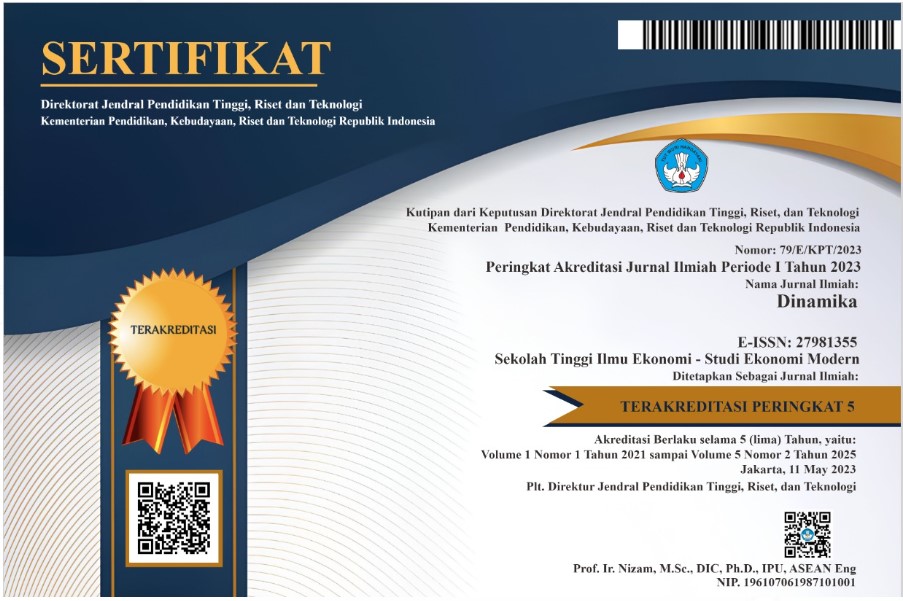EVALUASI PROYEK R&D DALAM UTILITAS TERATUR: KASUS UTILITAS TRANSMISI DAYA
DOI:
https://doi.org/10.51903/dinamika.v3i1.322Keywords:
R&D Project, Hierarchical Decision Model, Utilitas Transmisi DayaAbstract
Tujuan utama dari penelitian ini adalah untuk mengembangkan model pemilihan proyek R&D berdasarkan pendekatan holistik yang selaras dengan strategi, tujuan utilitas, dan kondisi pasar di sektor transmisi listrik. Pada saat yang sama, ini mengidentifikasi, mengkategorikan, dan mengukur faktor-faktor yang terkait dengan proyek R&D di sektor ketenagalistrikan. Konsep analisis menjadi model multikriteria HDM yang mempertimbangkan semua aspek yang terkait dengan proyek R&D. Latar belakang masalah: Pemilihan proyek R&D sangat penting bagi banyak organisasi, dan ini merupakan keputusan yang kompleks karena dipengaruhi oleh banyak faktor yang bervariasi antar organisasi karena tujuan dan kondisi yang berbeda. Ada anggaran terbatas untuk investasi, dan metode pemilihan proyek R&D saat ini difokuskan pada analisis keuangan atau perhitungan probabilistik matematis yang rumit. Kebaruan: model penelitian ini adalah untuk membuat metode untuk membantu meningkatkan pemilihan ex-ante proyek R&D di organisasi yang diatur terutama sektor utilitas transmisi listrik, yang memainkan salah satu peran terpenting dalam keseluruhan sistem tenaga listrik. Metode Penelitian: HDM (Hierarchical Decision Model) dipilih sebagai metode untuk mengevaluasi proyek R&D dalam penelitian ini. Kategori dan faktor yang terkait dengan proyek R&D dalam organisasi yang diatur dibagi menjadi empat tingkatan: 1) Misi, 2) Kriteria, 3) Subkriteria, dan 4) Alternatif. Model dan penerapannya berpotensi berlaku untuk organisasi nirlaba dan teregulasi di seluruh dunia. Hasil Temuan: Hasil penelitian ini menunjukkan bahwa bobot alternatif harus berbeda secara signifikan untuk memberikan efek yang cukup besar pada setting alternatif dengan mengubah bobot kriteria. Selain Technical Success, time to market, dan strategic fit sebagai subkriteria dengan bobot tertinggi, regulasi untuk mempertahankan tingkat reliabilitas yang tinggi menjadi penting. Kesimpulan: Penyesuaian model dengan karakteristik yang berbeda merupakan area penelitian yang potensial untuk dilakukan. Model yang digunakan memberikan analisis kuantitatif untuk alternatif berdasarkan utilitas tertentu, sehingga mengadaptasi model ke skenario dan kondisi lain adalah penting dan akan menjadi langkah penting untuk menggeneralisasi model.
References
A. J. Brunett, D. Grabaskas, M. Bucknor, and S. Passerini, “A methodology for the integration of passive system reliability with success criteria in a probabilistic framework for advanced reactors,” American Society of Mechanical Engineers (ASME), Argonne, IL, US., 2016.
A. Jekunen, “Decision-making in product portfolios of pharmaceutical research and development - managing streams of innovation in highly regulated markets,” Drug Design, Development and Therapy, p. 2009, Oct. 2014.
A. Morton, J. Keisler, and A. Salo, “Multicriteria portfolio decision analysis for project selection,” in International Series in Operations Research & Management Science, vol. 233, F. J. (eds) Greco S., Ehrgott M., Ed. New York, US.: Springer, 2016.
B. R. Fonslow et al., “NIH Public Access,” Adm Policy Ment Health, vol. 10, no. 1, pp. 54–56, 2013.
B. Wang, K. Narvekar, and T. Nguyen, “The hierarchical decision model for non-profit organization’s project selection,” in 2013 Portland International Conference on Management of Engineering and Technology, PICMET 2013, 2013, pp. 401–410.
C. J. M. Victório, H. G. Costa, and C. G. de Souza, “Modeling selection criteria of R&D projects for awarding direct subsidies to the private sector,” Science and Public Policy, vol. 43, no. 2, pp. 275–287, Apr. 2016.
C. Li, Y. Liu, and S. Li, “Risk evaluation of Qinghai-Tibet power grid interconnection project for sustainability,” Sustainability (Switzerland), vol. 8, no. 1, pp. 1–19, 2016.
C. Okoli and S. D. Pawlowski, “The Delphi method as a research tool: an example, design considerations and applications,” Information & Management, vol. 42, no. 1, pp. 15–29, Dec. 2004.
C.-C. Huang, P.-Y. Chu, and Y.-H. Chiang, “A fuzzy AHP application in government-sponsored R&D project selection,” Omega, vol. 36, no. 6, pp. 1038–1052, Dec. 2008.
C.-T. Chen and W.-Z. Hung, “Applying fuzzy linguistic variable and ELECTRE method in R&D project evaluation and selection,” in 2008 IEEE International Conference on Industrial Engineering and Engineering Management, 2008, pp. 999–1003.
D. Grabaskas, A. J. Brunett, and M. Bucknor, “A methodology for the integration of a mechanistic source term analysis in a probabilistic framework for advanced reactors,” in 2016 24th International Conference on Nuclear Engineering, ICONE 2016, 2016, vol. 2.
D. P. Tuttle et al., “The history and evolution of the U.S. electricity industry,” University of Texas - Energy Institute, Austin, TX, Apr. 2016.
D. Qiushi, W. Guan-Nan, and C. Li, “Project evaluation of jilin rural power grid reformation based on rough set and support vector machine,” in 14th International Symposium on Distributed Computing and Applications for Business, Engineering and Science, DCABES 2015, 2016, pp. 489–492.
D. Yakovlev, E. Yushkov, A. Pryakhin, and M. Bogatyreova, “Effectiveness evaluation of the R&D projects in organizations financed by the budget expenses,” International Conference for Young Scientists, Specialists, and Postgraduates on Nuclear Reactor Physics 2016, ICNRP 2016, vol. 781, no. 1, 2017.
E. Garces, K. van Blommestein, J. Anthony, J. Hillegas-Elting, T. Daim, and B. S. Yoon, “Technology domain analysis: A case of energy-efficient advanced commercial refrigeration technologies,” Sustainable Production and Consumption, vol. 12, no. December 2016, pp. 221–233, 2017.
E. Gibson, “A measurement system for science and engineering research center performance evaluation,” Engineering and Technology Management - Portland State University, Oregon, 2016.
F. J. Wang and Y. Lu, “Fuzzy analytic hierarchy process based comprehensive evaluation of distribution materials standardization projects,” in 5th International Symposium on Project Management, ISPM 2017, 2017, pp. 668–675.
F. Liang, X. Lv, J. Liu, W. Zhang, X. Liu, and B. Gao, “Evaluation of investment projects on distribution network based on fuzzy algorithms,” in 5th Annual IEEE International Conference on Cyber Technology in Automation, Control and Intelligent Systems, IEEE-CYBER 2015, 2015, pp. 761–766.
G. Lu, H. Luan, W. He, and Y. Ma, “Decision model research on engineering project arrangement of power grid enterprise group based on input and output efficiency evaluation,” in International Conference on Engineering Technology and Application, ICETA 2015, 2015, vol. 22.
J. Behrens, “A lack of insight: An experimental analysis of R&D managers’ decision making in innovation portfolio management,” Creativity and Innovation Management, vol. 25, no. 2, pp. 239–250, Jun. 2016.
J. Estep, “Development of a technology transfer score for evaluating research proposals: Case study of demand response technologies in the Pacific Northwest,” Engineering and Technology Management, Portland State University, Oregon, USA, 2016.
J. Tarbert, “Public power’s business model: A primer.” Public Power and the American Public Power Association, 2012.
K. Costello, “R&D and public utilities,” Electricity Journal, vol. 29, no. 5, pp. 19–26, 2016.
K. Lauritzen, “Method for optimal capability-based R&D portfolio selection,” in 2014 IEEE International Technology Management Conference, 2014, pp. 1–4.
M. Ashrafi, H. Davoudpour, and M. Abbassi, “Developing a decision support system for R&D project portfolio selection with interdependencies,” AIP Conference Proceedings, vol. 1499, no. 1, pp. 370–378, Nov. 2012.
M. J. Liberatore, “An expert support system for R&D project selection,” Mathematical and Computer Modelling, vol. 11, pp. 260–265, 1988.
M. N. M. Arratia, I. F. López, S. E. Schaeffer, and L. Cruz-Reyes, “Static R&D project portfolio selection in public organizations,” Decision Support Systems, vol. 84, pp. 53–63, 2016.
M. T. Booher, D. F. Proaño, and K. Kash, “PLC - Electricity regulation in the United States: overview,” Practical Law, 13-Mar-2016. [Online]. Available: http://us.practicallaw.com/8-525-5799?source=relatedcontent#a1003615.
N. M. Arratia M., F. Lόpez I., S. E. Schaeffer, and L. Cruz-Reyes, “Static R&D project portfolio selection in public organizations,” Decision Support Systems, vol. 84, pp. 53–63, Apr. 2016.
P. Guo, J. J. Liang, Y. M. Zhu, and J. F. Hu, “R&D project portfolio selection model analysis within project interdependencies context,” in 2008 IEEE International Conference on Industrial Engineering and Engineering Management, 2008, pp. 994–998.
R. Abotah, “Evaluation of energy policy instruments for the adoption of renewable energy: Case of wind energy in the Pacific Northwest,” Portland State University, Oregon, USA, 2014.
R. Mott, K. Keller, and K. Funkenbusch, “‘Keep me doing what I love’: A photovoice evaluation of the Missouri AgrAbility Project,” Journal of Agromedicine, vol. 22, no. 4, pp. 425–431, 2017.
R. Neshati and T. U. Daim, “Participation in technology standards development: A decision model for the information and communications technology (ICT) industry,” The Journal of High Technology Management Research, vol. 28, no. 1. pp. 47–60, 2017.
S. Hashemkhani Zolfani, J. Salimi, R. Maknoon, and S. Kildienė, “Technology Foresight about R&D projects selection: Application of SWARA method at the policy making level,” Engineering Economics, vol. 26, no. 5, Dec. 2015.
S. Managi, Z. Zhang, and S. Horie, “A real options approach to environmental R&D project evaluation,” Environmental Economics and Policy Studies, vol. 18, no. 3, pp. 359–394, 2016.
S. Schmitt and K. Denes, “The impact of the regulatory reform process on R&D investment of european electricity utilities,” in Beiträge zur Jahrestagung des Vereins für Socialpolitik, 2013.
T. Sakai et al., “Activities of the safety and operation project for the international research and development of the sodium-cooled fast reactor in the generation IV international forum,” in 2016 24th International Conference on Nuclear Engineering, ICONE 2016, 2016, vol. 2.
T. Silva, M. Jian, and Y. Chen, “Process analytics approach for R&D project selection,” ACM Transactions on Management Information Systems, vol. 5, no. 4, 2014.
T. U. Daim, T. Oliver, and I. Iskin, “Research and development (R&D) portfolio management in the electric utility sector: Does it change for the service sector?” Benchmarking: An International Journal, vol. 20, no. 2, pp. 186–211, Apr. 2013.
W. Jingmei and G. Peng, “The robustness risk and selection optimization of R&D project portfolio under uncertainty,” in 2015 IEEE International Conference on Grey Systems and Intelligent Services (GSIS), 2015, pp. 622–627.
X. Li, X. Zhu, Q. Liao, and H. Sun, “Evaluation of power transmission and transformation projects using fuzzy multi-layer models,” International Journal of Simulation: Systems, Science and Technology, vol. 17, no. 47, pp. 21.1-21.6, 2016.
Y. Yi, Z. Chen, and L. Wang, “Statistical evaluation and prediction of audible noise of HVDC transmission lines,” in 2016 IEEE Conference on Electrical Insulation and Dielectric Phenomena, CEIDP 2016, 2016, vol. 2016-Decem, pp. 279–282.












